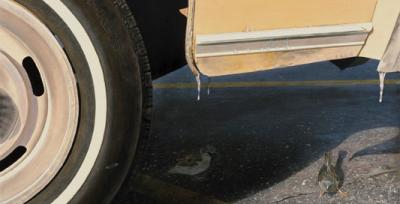Environmental Impact Statement
A traveling art exhibit that provides a look at what we have and what we may be losing.
Artistic talent applied to the global concern of environmental spoilage has never been so mesmerizing. Nor more beautiful.
The exhibit, Environmental Impact, at the Erie Art Museum until September 30, was curated by David J. Wagner, LLC, and is currently traveling the country. We are fortunate that our art museum chose to show it.
In this exhibit, there are works that bring us closer to nature, showing us what we still have or, put another way, what we are losing, and there are others that thrust our detritus at us in no uncertain terms.
Lucia deLeiris' large paintings "Ross Sea" and "Greenland Sea" draw us in with their sparse, luminous expanses of blue and frozen stillness. Once drawn, of course, we see the subtle cracks, the melting, the new warmth that shouldn't really be there.
deLeiris' subtlety is juxtaposed with pieces by other artists who are more didactic in their symbolism. Walter Furgenson's "Save the Seashore" gives us an innocent toddler building sand castles alongside a wrack line filled with trash and a partially buried tire. In "Apocalypse," he perches an egret near a ramshackle dock across from a nuclear power plant. The plant, new-looking and belching emissions – the sign of human achievement for many years – makes the dilapidated foreshore, filled with debris, even more melancholy. As a final touch, Ferguson captures two egrets flying out of the picture, departing from this waterway that no longer sustains life.
In everything here, the intersection of nature and humanity is apparent. Some artists choose a grand scale to make their point, others look to the smaller, more personal manner of the relationship. Mick Meilahn's "Reality" dominates the main gallery with monumental hanging ears of corn made of blown glass and cast bronze. It suggests the dangers of genetically modified foods, and Meilahn, in making the pieces so imposingly large, heightens our sense of concern for genetic engineering's ability to alter the future.
Rick Pas goes in a different direction, giving us "Parking Lot Sparrows," which shows an open car door over house sparrows feeding on crumbs on an asphalt surface. A small, perhaps insignificant, moment that many of us experience every day, and we, perhaps, give little thought to. Pas wants us to give those birds a thought, suggesting that, in these modern times, this may be the only encounter with nature we have.
But of course, on the grandest of levels, our relationship with the earth is not as simple as stopping to enjoy it every now and then, nor is preserving it as simple as leaving it alone. We need the Earth to sustain us; we must use it somehow if we are to live. Many works here are successful at making us ask the harder questions, as they reveal the complex nature of what we do and how we think about our impact on the environment.
In "Homes Built on Prime Farmland," Robert Dawson mourns the use of the farmland for a housing development, showing us the waste of land that could be used to grow food for a hungry planet. Farther down the row of photographs, though, he mourns the loss of wild nature in "Former Mangrove Forest, Now a Shrimp Farm." This is not an easy dance.
So many other pieces are worthy of your time: Peter Goin's panoramic landscapes that delicately suggest the damage we've caused, Lisa Lebofsky's "Petzval Glacier," lyrically painted on aluminum to underscore the steely cold of the arctic, and Robert Bateman's suite of acrylics, especially "Driftnet," that demonstrates, with a discriminating hand, our effects on the land and water. Another highlight is Edward Burtynsky's color print "Oxford Tire Pile #2, Westley, California," which somehow manages to show us the despair of our waste and do so with a sweeping elegance.
There is much here that is rich in style, color, and symbolism, from the lushly detailed works by artists who see nature with Rousseauian eyes (Henri, not Jean-Jacques) to those who present it with abstract, conceptual brush strokes and modern imagery.
The works here are breathtakingly beautiful, but their message is heartbreakingly tragic.
Environmental Impact is currently on display at the Erie Art Museum, located at 20 E. Fifth St., from Aug. 1 to Sept. 30..
Mary Birdsong can be contacted at mBirdsong@ErieReader.com, and you can follow her on Twitter @Mary_Birdsong.


.png)
